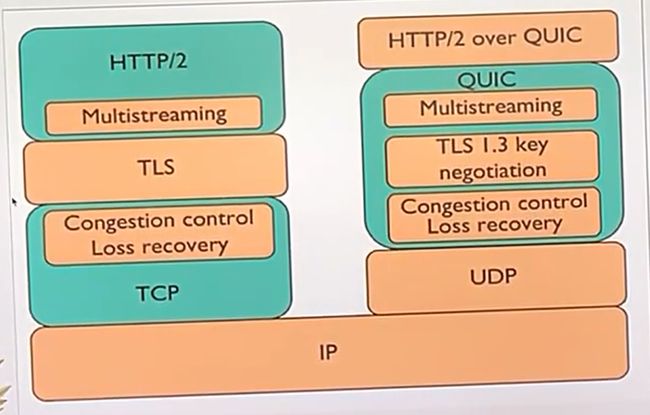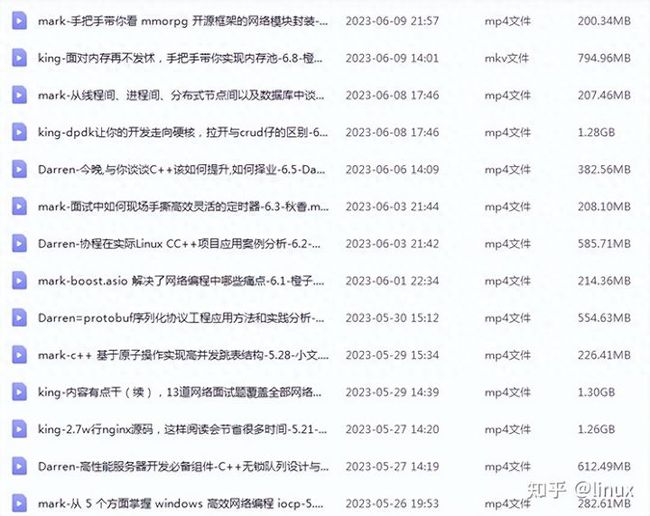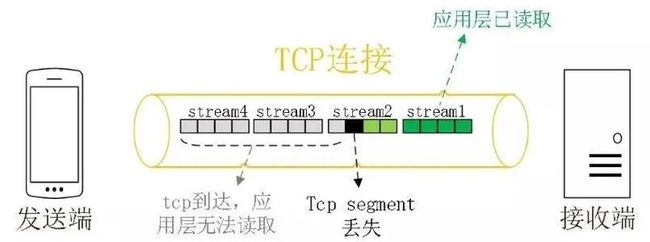quic协议及核心源码分析
quic协议
1、网络通信时,为了确保数据不丢包,早在几十年前就发明了tcp协议!然而此一时非彼一时,随着技术进步和业务需求增多,tcp也暴露了部分比较明显的缺陷,比如:
-
建立连接的3次握手延迟大; TLS需要至少需要2个RTT,延迟也大
-
协议缺陷可能导致syn反射类的DDOS攻击
-
tcp协议紧耦合到了操作系统,升级需要操作系统层面改动,无法快速、大面积推广升级补丁包
-
对头阻塞:数据被分成sequence,一旦中间的sequence丢包,后面的sequence也不会处理
-
中转设备僵化:路由器、交换机等设备“认死理”,比如只认80、443等端口,其他端口一律丢弃
为了解决这些问题,牛逼plus的google早在10年前,也就是2012年发布了基于UDP的quic协议!为啥不基于tcp了,因为tcp有上述5条缺陷的嘛,所以干脆“另起炉灶”重新开搞!
2、正式介绍前,先看一张图:quci在右边,底层用了udp的协议;自生实现了Multistreaming、tls、拥塞控制,然后支撑了上层的http/2,所以我个人理解quic是一个夹在应用层和传输层之间的协议!
上面“数落”了tcp协议的5点不是,quic又是怎么基于udp解决这些问题的了?quic 是基于 UDP 实现的协议,而 UDP 是不可靠的面向报文的协议,这和 TCP 基于 IP 层的实现并没有什么本质上的不同,都是:
-
底层只负责尽力而为的,以 packet 为单位的传输;
-
上层协议实现更关键的特性,如可靠,有序,安全等。
(1)由于quic并未改造udp,而是直接使用udp,所以不需要改动现有的操作系统,也兼容了现有的网络中转设备,这些都不需要做任何改动,所以quic部署的改造成本相对较低!但是quic毕竟是新的协议,在哪部署和使用了?只有应用层了!这个和操作系统是解耦的,全靠3环的app自己想办法实现(和之前介绍的协程是不是类似了?)!google已经开源了算法,下载连接见文章末尾的参考5;PS:微软也实现了QUIC协议,名称叫MsQuic,源码在这:https://github.com/microsoft/msquic;
这里多说几句:应用层app能操作的最底层协议就是传输层了。大家在用libc库编写通信代码时可以对指定的ip地址和端口收发数据,没法改自己的mac地址吧?也没法改自己的ip地址吧?这些都是操作系统内核封装的,app的开发人员是不需要、也是没法改变的,所以站在安全防护的角度,部分大厂基于传输层自研了类似quic的通信协议,逆向时需要人工挨个分析协议字段的含义了,现成的fiddler/charles/burpsuit等https/http的抓包工具是无效的,用wireshark这类工具抓包也无法自动解析这些厂家自研的协议!
(2)TCP连接需要3次握手,tls最少需要2次RTT,两个加起来一共要耗费5个RTT,究其原因一方面是 TCP 和 TLS 分层设计导致的:分层的设计需要每个逻辑层次分别建立自己的连接状态。另一方面是 TLS 的握手阶段复杂的密钥协商机制导致的,quic又是怎么改进的了?quic建立握手的步骤如下:
-
客户端判断本地是否已有服务器的全部配置参数(证书配置信息),如果有则直接跳转到(5),否则继续 。
-
客户端向服务器发送 inchoate client hello(CHLO) 消息,请求服务器传输配置参数。
-
服务器收到 CHLO,回复 rejection(REJ) 消息,其中包含服务器的部分配置参数
-
客户端收到 REJ,提取并存储服务器配置参数,跳回到 (1) 。
-
客户端向服务器发送 full client hello 消息,开始正式握手,消息中包括客户端选择的公开数。此时客户端根据获取的服务器配置参数和自己选择的公开数,可以计算出初始密钥 K1。
-
服务器收到 full client hello,如果不同意连接就回复 REJ,同(3);如果同意连接,根据客户端的公开数计算出初始密钥 K1,回复 server hello(SHLO) 消息, SHLO 用初始密钥 K1 加密,并且其中包含服务器选择的一个临时公开数。
-
客户端收到服务器的回复,如果是 REJ 则情况同(4);如果是 SHLO,则尝试用初始密钥 K1 解密,提取出临时公开数。
-
客户端和服务器根据临时公开数和初始密钥 K1,各自基于 SHA-256 算法推导出会话密钥 K2。
-
双方更换为使用会话密钥 K2 通信,初始密钥 K1 此时已无用,QUIC 握手过程完毕。之后会话密钥 K2 更新的流程与以上过程类似,只是数据包中的某些字段略有不同。这里为啥不继续使用key1,而是要重新生成key2来加密了?核心是为了前向安全!万一key1泄漏,之前用key1加密的数据全都被解密。所以为了前向安全,每次通信时会重新生成key2加密!
总的来说:
-
udp本身就不是面向连接的协议,所以省略了tcp 3次握手连接的耗时;直接通过事先内置的服务器参数发起通信请求;
-
既然不是面向连接的,怎么确保所有的数据都能到达了?通过stream id和stream offset确保数据包不会丢失,接收方能收到完整的全量数据
-
第一次用DH算法计算对称加密的密钥需要1个RTT;后续每次都用这个缓存的密钥加密,又省了一个RTT;本质上是把tcp的打招呼、握手,还有tls交换密钥的工作在1个RTT中全做了,这就是相比于tcp实现的tls效率高的根本原因!
注意:通信双方用于密钥交换的DH算法无法防止中间人攻击,所以仅通过密钥交换是无法防止被抓包的,所以还要通过证书等其他方式验证身份!x音就是通过libboringssl.so(google开源的一个openssl分支)SSL_CTX_set_custom_verify函数验证客户端是否是原来的client,而不是抓包软件!
相关视频推荐
Linux C/C++开发(后端/音视频/游戏/嵌入式/高性能网络/存储/基础架构/安全)![]() https://link.zhihu.com/?target=https%3A//ke.qq.com/course/417774%3FflowToken%3D1013300
https://link.zhihu.com/?target=https%3A//ke.qq.com/course/417774%3FflowToken%3D1013300
需要C/C++ Linux服务器架构师学习资料加qun812855908获取(资料包括C/C++,Linux,golang技术,Nginx,ZeroMQ,MySQL,Redis,fastdfs,MongoDB,ZK,流媒体,CDN,P2P,K8S,Docker,TCP/IP,协程,DPDK,ffmpeg等),免费分享
(3)拥塞控制:QUIC 使用可插拔的拥塞控制,相较于 TCP,它能提供更丰富的拥塞控制信息。比如对于每一个包,不管是原始包还是重传包,都带有一个新的序列号(seq),这使得 QUIC 能够区分 ACK 是重传包还是原始包,从而避免了 TCP 重传模糊的问题。QUIC 同时还带有收到数据包与发出 ACK 之间的时延信息。这些信息能够帮助更精确的计算 RTT!同时,因为quic不依赖操作系统,而是在应用层实现,所以开发人员对于quic有非常强的操控能力:完全可以根据不同的业务场景,实现和配置不同的拥塞控制算法以及参数;比如Google 提出的 BBR 拥塞控制算法与 CUBIC 是思路完全不一样的算法,在弱网和一定丢包场景,BBR 比 CUBIC 更不敏感,性能也更好;
(4)队头阻塞:TCP 为了保证可靠性,使用了基于字节序号的 Sequence Number 及 Ack 来确认消息的有序到达;一旦中间某个sequence的包丢失,哪怕是这个sequence后面的数据已经到达接收端,操作系统也不会立即把数据发给上层的应用来接受处理,而是一直等待发送端重新发送丢失的sequence包,举例如下:
应用层可以顺利读取 stream1 中的内容,但由于 stream2 中的第三个 segment 发生了丢包,TCP 为了保证数据的可靠性,需要发送端重传第 3 个 segment 才能通知应用层读取接下去的数据。所以即使 stream3、stream4 的内容已顺利抵达,应用层仍然无法读取,只能等待 stream2 中丢失的包进行重传。在弱网环境下,HTTP2 的队头阻塞问题在用户体验上极为糟糕!quic是怎么既确保数据传输可靠不丢失,又解决队头阻塞的这个问题的了?
对于数据包的传输,肯定是要编号的,否则接受方在拼接这些数据包的时候怎么知道顺序了?quic协议用Packet Number 代替了 TCP 的 Sequence Number,不同之处在于:
-
每个 Packet Number 都严格递增,也就是说就算 Packet N 丢失了,重传的 Packet N 的 Packet Number 已经不是 N,而是一个比 N 大的值,比如Packet N+M;
-
数据包支持乱序确认,不再要求 TCP 那样必须有序确认
当数据包 Packet N 丢失后,只要有新的已接收数据包确认,当前窗口就会继续向右滑动。待发送端获知数据包 Packet N 丢失后,会将需要重传的数据包放到待发送队列,重新编号比如数据包 Packet N+M 后重新发送给接收端,对重传数据包的处理跟发送新的数据包类似,这样就不会因为丢包重传将当前窗口阻塞在原地,从而解决了队头阻塞问题;但是问题又来了:怎么确认Package N+M就是重传PackageN的数据包了?这就涉及到quic另一个重要的特性了:多路复用!比如用户访问某个网页,这个页面有两个文件,分别是index.htm和index.js,可以同时、分别传输这两个文件!每个传输的stream都有各自的id,所以可以通过id确认是哪个stream超时丢包了!但包的Packet 编号是N+M,怎么进一步确认就是重传的Packet N包了?这就需要另一个重要的变量了:offset!怎么样,单从英语是不是就能猜到这个变量的作用了?每个数据包都有个offset字段,用于标识在stream id中的偏移!接收方完全可以根据offset来拼接收到的数据包!
总结:quic协议可以在乱序发送的情况下任然可靠不丢失,靠的就是每个数据包的offset字段;再搭配上stream id字段,接收方完全可以在乱序的情况下无误拼接收到的数据包了!
(4)除了以上通过stream id和stream offset确保数据不丢失外,quic还采用了另一个叫向前纠错 (Forward Error Correction,FEC)的校验方式:即每个数据包除了它本身的内容之外,还包括了部分其他数据包的数据,因此少量的丢包可以通过其他包的冗余数据直接组装而无需重传。向前纠错牺牲了每个数据包可以发送数据的上限,但是减少了因为丢包导致的数据重传,因为数据重传将会消耗更多的时间(包括确认数据包丢失、请求重传、等待新数据包等步骤的时间消耗);这个原理和纠删码没有本质区别!
(5)通信双方不论使用何种协议,发送的数据必须事前约定好格式,否则接受方怎么从数据包(本质就是一段字符串)中解析和提取关键的信息了?quic协议的格式如下:
数据包中除了个别报文比如 PUBLIC_RESET 和 CHLO,所有报文头部(上图红色部分)都是经过认证的(哈希散列值),报文 Body (上图绿色部分)都是经过加密的,这样只要对 QUIC 报文任何修改,接收端都能够及时发现;每个字段的含义如下:
-
Flags:用于表示 Connection ID 长度、Packet Number 长度等信息;
-
Connection ID:客户端随机选择的最大长度为64位的无符号整数,用于标识连接;如果app更换了ip地址(比如wifi和4G之间切换了),仍然可以通过这个id和服务端在0 RTT下通信!
-
QUIC Version:QUIC 协议的版本号,32 位的可选字段。如果 Public Flag & FLAG_VERSION != 0,这个字段必填。客户端设置 Public Flag 中的 Bit0 为1,并且填写期望的版本号。如果客户端期望的版本号服务端不支持,服务端设置 Public Flag 中的 Bit0 为1,并且在该字段中列出服务端支持的协议版本(0或者多个),并且该字段后不能有任何报文;
-
Packet Number:长度取决于 Public Flag 中 Bit4 及 Bit5 两位的值,最大长度 6 字节。发送端在每个普通报文中设置 Packet Number。发送端发送的第一个包的序列号是 1,随后的数据包中的序列号的都大于前一个包中的序列号;
-
Stream ID:用于标识当前数据流属于哪个资源请求,用于消除队头阻塞;
-
Offset:标识当前数据包在当前 Stream ID 中的字节偏移量,用于消除队头阻塞。
(6)为了便于理解和记忆,这里把quic的要点做了总结,如下:
3、正式因为quic有这么多优点,国内很多互联网一、二线厂商都开始采用,其中比较著名的app就是x音了!lib库中有个libsscronet.so就支持quic协议!
quic协议核心源码
quic协议最早是google提出来的,所以狗家的源码肯定是最“正宗”的!
1、quic相比tcp实现的tls,前面省略了3~4个RTT,根因就是发起连接请求时就发送自己的公钥给对方,让对方利用自己的公钥计算后续对称加密的key,这就是所谓的handshake;在libquic-master\src\net\quic\core\quic_crypto_client_stream.cc中有具体实现握手的代码,先看DoHandshakeLoop函数:
void QuicCryptoClientStream::DoHandshakeLoop(const CryptoHandshakeMessage* in) {
QuicCryptoClientConfig::CachedState* cached =
crypto_config_->LookupOrCreate(server_id_);
QuicAsyncStatus rv = QUIC_SUCCESS;
do {
CHECK_NE(STATE_NONE, next_state_);
const State state = next_state_;
next_state_ = STATE_IDLE;
rv = QUIC_SUCCESS;
switch (state) {
case STATE_INITIALIZE:
DoInitialize(cached);
break;
case STATE_SEND_CHLO:
DoSendCHLO(cached);
return; // return waiting to hear from server.
case STATE_RECV_REJ:
DoReceiveREJ(in, cached);
break;
case STATE_VERIFY_PROOF:
rv = DoVerifyProof(cached);
break;
case STATE_VERIFY_PROOF_COMPLETE:
DoVerifyProofComplete(cached);
break;
case STATE_GET_CHANNEL_ID:
rv = DoGetChannelID(cached);
break;
case STATE_GET_CHANNEL_ID_COMPLETE:
DoGetChannelIDComplete();
break;
case STATE_RECV_SHLO:
DoReceiveSHLO(in, cached);
break;
case STATE_IDLE:
// This means that the peer sent us a message that we weren't expecting.
CloseConnectionWithDetails(QUIC_INVALID_CRYPTO_MESSAGE_TYPE,
"Handshake in idle state");
return;
case STATE_INITIALIZE_SCUP:
DoInitializeServerConfigUpdate(cached);
break;
case STATE_NONE:
NOTREACHED();
return; // We are done.
}
} while (rv != QUIC_PENDING && next_state_ != STATE_NONE);
}只要quic的状态不是pending,并且下一个状态不是NONE,就根据不同的状态调用不同的处理函数!具体发送handshake小的函数是DoSendCHLO,代码如下:
/*发送client hello消息*/
void QuicCryptoClientStream::DoSendCHLO(
QuicCryptoClientConfig::CachedState* cached) {
if (stateless_reject_received_) {//如果收到了server拒绝的消息
// If we've gotten to this point, we've sent at least one hello
// and received a stateless reject in response. We cannot
// continue to send hellos because the server has abandoned state
// for this connection. Abandon further handshakes.
next_state_ = STATE_NONE;
if (session()->connection()->connected()) {
session()->connection()->CloseConnection(//关闭连接
QUIC_CRYPTO_HANDSHAKE_STATELESS_REJECT, "stateless reject received",
ConnectionCloseBehavior::SILENT_CLOSE);
}
return;
}
// Send the client hello in plaintext.
//注意:这是client hello消息,没必要加密
session()->connection()->SetDefaultEncryptionLevel(ENCRYPTION_NONE);
encryption_established_ = false;
if (num_client_hellos_ > kMaxClientHellos) {//握手消息已经发送了很多,不能再发了
CloseConnectionWithDetails(
QUIC_CRYPTO_TOO_MANY_REJECTS,
base::StringPrintf("More than %u rejects", kMaxClientHellos).c_str());
return;
}
num_client_hellos_++;
//开始构造握手消息了
CryptoHandshakeMessage out;
DCHECK(session() != nullptr);
DCHECK(session()->config() != nullptr);
// Send all the options, regardless of whether we're sending an
// inchoate or subsequent hello.
/*填充握手消息的各个字段*/
session()->config()->ToHandshakeMessage(&out);
// Send a local timestamp to the server.
out.SetValue(kCTIM,
session()->connection()->clock()->WallNow().ToUNIXSeconds());
if (!cached->IsComplete(session()->connection()->clock()->WallNow())) {
crypto_config_->FillInchoateClientHello(
server_id_, session()->connection()->supported_versions().front(),
cached, session()->connection()->random_generator(),
/* demand_x509_proof= */ true, &crypto_negotiated_params_, &out);
// Pad the inchoate client hello to fill up a packet.
const QuicByteCount kFramingOverhead = 50; // A rough estimate.
const QuicByteCount max_packet_size =
session()->connection()->max_packet_length();
if (max_packet_size <= kFramingOverhead) {
DLOG(DFATAL) << "max_packet_length (" << max_packet_size
<< ") has no room for framing overhead.";
CloseConnectionWithDetails(QUIC_INTERNAL_ERROR,
"max_packet_size too smalll");
return;
}
if (kClientHelloMinimumSize > max_packet_size - kFramingOverhead) {
DLOG(DFATAL) << "Client hello won't fit in a single packet.";
CloseConnectionWithDetails(QUIC_INTERNAL_ERROR, "CHLO too large");
return;
}
// TODO(rch): Remove this when we remove:
// FLAGS_quic_use_chlo_packet_size
out.set_minimum_size(
static_cast(max_packet_size - kFramingOverhead));
next_state_ = STATE_RECV_REJ;
/*做hash签名,接收方会根据hash验证消息是否完整*/
CryptoUtils::HashHandshakeMessage(out, &chlo_hash_);
//发送消息
SendHandshakeMessage(out);
return;
}
// If the server nonce is empty, copy over the server nonce from a previous
// SREJ, if there is one.
if (FLAGS_enable_quic_stateless_reject_support &&
crypto_negotiated_params_.server_nonce.empty() &&
cached->has_server_nonce()) {
crypto_negotiated_params_.server_nonce = cached->GetNextServerNonce();
DCHECK(!crypto_negotiated_params_.server_nonce.empty());
}
string error_details;
/*继续填充client hello消息*/
QuicErrorCode error = crypto_config_->FillClientHello(
server_id_, session()->connection()->connection_id(),
session()->connection()->version(),
session()->connection()->supported_versions().front(), cached,
session()->connection()->clock()->WallNow(),
//这个随机数会被server用来计算生成对称加密的key
session()->connection()->random_generator(),
channel_id_key_.get(),
//保存了nonce、key、token相关信息;后续对称加密的方法是CTR,需要NONCE值
&crypto_negotiated_params_,
&out, &error_details);
if (error != QUIC_NO_ERROR) {
// Flush the cached config so that, if it's bad, the server has a
// chance to send us another in the future.
cached->InvalidateServerConfig();
CloseConnectionWithDetails(error, error_details);
return;
}
/*继续对消息做hash,便于server验证收到的消息是否完整*/
CryptoUtils::HashHandshakeMessage(out, &chlo_hash_);
channel_id_sent_ = (channel_id_key_.get() != nullptr);
if (cached->proof_verify_details()) {
proof_handler_->OnProofVerifyDetailsAvailable(
*cached->proof_verify_details());
}
next_state_ = STATE_RECV_SHLO;
SendHandshakeMessage(out);
// Be prepared to decrypt with the new server write key.
session()->connection()->SetAlternativeDecrypter(
ENCRYPTION_INITIAL,
crypto_negotiated_params_.initial_crypters.decrypter.release(),
true /* latch once used */);
// Send subsequent packets under encryption on the assumption that the
// server will accept the handshake.
session()->connection()->SetEncrypter(
ENCRYPTION_INITIAL,
crypto_negotiated_params_.initial_crypters.encrypter.release());
session()->connection()->SetDefaultEncryptionLevel(ENCRYPTION_INITIAL);
// TODO(ianswett): Merge ENCRYPTION_REESTABLISHED and
// ENCRYPTION_FIRST_ESTABLSIHED
encryption_established_ = true;
session()->OnCryptoHandshakeEvent(QuicSession::ENCRYPTION_REESTABLISHED);
} 个人觉得最核心的代码就是FillClientHello函数了,这里会生成随机数,后续server会利用这个随机数生成对称加密的key!部分通信的参数也会通过这个函数的执行保存在crypto_negotiated_params_对象中!client发送了hello包,接下来该server处理这个包了,代码在libquic-master\src\net\quic\core\quic_crypto_server_stream.cc和quic_crypto_server_config.cc中,代码如下:核心功能是生成自己的公钥,还有后续对称加密的key!
QuicErrorCode QuicCryptoServerConfig::ProcessClientHello(
const ValidateClientHelloResultCallback::Result& validate_chlo_result,
bool reject_only,
QuicConnectionId connection_id,
const IPAddress& server_ip,
const IPEndPoint& client_address,
QuicVersion version,
const QuicVersionVector& supported_versions,
bool use_stateless_rejects,
QuicConnectionId server_designated_connection_id,
const QuicClock* clock,
QuicRandom* rand,//发送给client用于计算对称key
QuicCompressedCertsCache* compressed_certs_cache,
QuicCryptoNegotiatedParameters* params,
QuicCryptoProof* crypto_proof,
QuicByteCount total_framing_overhead,
QuicByteCount chlo_packet_size,
CryptoHandshakeMessage* out,
DiversificationNonce* out_diversification_nonce,
string* error_details) const {
DCHECK(error_details);
const CryptoHandshakeMessage& client_hello =
validate_chlo_result.client_hello;
const ClientHelloInfo& info = validate_chlo_result.info;
QuicErrorCode valid = CryptoUtils::ValidateClientHello(
client_hello, version, supported_versions, error_details);
if (valid != QUIC_NO_ERROR)
return valid;
StringPiece requested_scid;
client_hello.GetStringPiece(kSCID, &requested_scid);
const QuicWallTime now(clock->WallNow());
scoped_refptr requested_config;
scoped_refptr primary_config;
{
base::AutoLock locked(configs_lock_);
if (!primary_config_.get()) {
*error_details = "No configurations loaded";
return QUIC_CRYPTO_INTERNAL_ERROR;
}
if (!next_config_promotion_time_.IsZero() &&
next_config_promotion_time_.IsAfter(now)) {
SelectNewPrimaryConfig(now);
DCHECK(primary_config_.get());
DCHECK_EQ(configs_.find(primary_config_->id)->second, primary_config_);
}
// Use the config that the client requested in order to do key-agreement.
// Otherwise give it a copy of |primary_config_| to use.
primary_config = crypto_proof->config;
requested_config = GetConfigWithScid(requested_scid);
}
if (validate_chlo_result.error_code != QUIC_NO_ERROR) {
*error_details = validate_chlo_result.error_details;
return validate_chlo_result.error_code;
}
out->Clear();
if (!ClientDemandsX509Proof(client_hello)) {
*error_details = "Missing or invalid PDMD";
return QUIC_UNSUPPORTED_PROOF_DEMAND;
}
DCHECK(proof_source_.get());
string chlo_hash;
CryptoUtils::HashHandshakeMessage(client_hello, &chlo_hash);
// No need to get a new proof if one was already generated.
if (!crypto_proof->chain &&
!proof_source_->GetProof(server_ip, info.sni.as_string(),
primary_config->serialized, version, chlo_hash,
&crypto_proof->chain, &crypto_proof->signature,
&crypto_proof->cert_sct)) {
return QUIC_HANDSHAKE_FAILED;
}
StringPiece cert_sct;
if (client_hello.GetStringPiece(kCertificateSCTTag, &cert_sct) &&
cert_sct.empty()) {
params->sct_supported_by_client = true;
}
if (!info.reject_reasons.empty() || !requested_config.get()) {
BuildRejection(version, clock->WallNow(), *primary_config, client_hello,
info, validate_chlo_result.cached_network_params,
use_stateless_rejects, server_designated_connection_id, rand,
compressed_certs_cache, params, *crypto_proof,
total_framing_overhead, chlo_packet_size, out);
return QUIC_NO_ERROR;
}
if (reject_only) {
return QUIC_NO_ERROR;
}
const QuicTag* their_aeads;
const QuicTag* their_key_exchanges;
size_t num_their_aeads, num_their_key_exchanges;
if (client_hello.GetTaglist(kAEAD, &their_aeads, &num_their_aeads) !=
QUIC_NO_ERROR ||
client_hello.GetTaglist(kKEXS, &their_key_exchanges,
&num_their_key_exchanges) != QUIC_NO_ERROR ||
num_their_aeads != 1 || num_their_key_exchanges != 1) {
*error_details = "Missing or invalid AEAD or KEXS";
return QUIC_INVALID_CRYPTO_MESSAGE_PARAMETER;
}
size_t key_exchange_index;
if (!QuicUtils::FindMutualTag(requested_config->aead, their_aeads,
num_their_aeads, QuicUtils::LOCAL_PRIORITY,
¶ms->aead, nullptr) ||
!QuicUtils::FindMutualTag(requested_config->kexs, their_key_exchanges,
num_their_key_exchanges,
QuicUtils::LOCAL_PRIORITY,
¶ms->key_exchange, &key_exchange_index)) {
*error_details = "Unsupported AEAD or KEXS";
return QUIC_CRYPTO_NO_SUPPORT;
}
if (!requested_config->tb_key_params.empty()) {
const QuicTag* their_tbkps;
size_t num_their_tbkps;
switch (client_hello.GetTaglist(kTBKP, &their_tbkps, &num_their_tbkps)) {
case QUIC_CRYPTO_MESSAGE_PARAMETER_NOT_FOUND:
break;
case QUIC_NO_ERROR:
if (QuicUtils::FindMutualTag(
requested_config->tb_key_params, their_tbkps, num_their_tbkps,
QuicUtils::LOCAL_PRIORITY, ¶ms->token_binding_key_param,
nullptr)) {
break;
}
default:
*error_details = "Invalid Token Binding key parameter";
return QUIC_INVALID_CRYPTO_MESSAGE_PARAMETER;
}
}
StringPiece public_value;
/*提取client hello数据包发送的公钥,server要用来生成对称加密的key*/
if (!client_hello.GetStringPiece(kPUBS, &public_value)) {
*error_details = "Missing public value";
return QUIC_INVALID_CRYPTO_MESSAGE_PARAMETER;
}
const KeyExchange* key_exchange =
requested_config->key_exchanges[key_exchange_index];
if (!key_exchange->CalculateSharedKey(public_value,
¶ms->initial_premaster_secret)) {
*error_details = "Invalid public value";
return QUIC_INVALID_CRYPTO_MESSAGE_PARAMETER;
}
if (!info.sni.empty()) {
std::unique_ptr sni_tmp(new char[info.sni.length() + 1]);
memcpy(sni_tmp.get(), info.sni.data(), info.sni.length());
sni_tmp[info.sni.length()] = 0;
params->sni = CryptoUtils::NormalizeHostname(sni_tmp.get());
}
string hkdf_suffix;
//client hello消息序列化,便于提取?
const QuicData& client_hello_serialized = client_hello.GetSerialized();
/*根据一个原始密钥材料,用hkdf算法推导出指定长度的密钥;
这里明显是要根据client hello的数据生成对称加密的密钥了
*/
hkdf_suffix.reserve(sizeof(connection_id) + client_hello_serialized.length() +
requested_config->serialized.size());
hkdf_suffix.append(reinterpret_cast(&connection_id),
sizeof(connection_id));
hkdf_suffix.append(client_hello_serialized.data(),
client_hello_serialized.length());
hkdf_suffix.append(requested_config->serialized);
DCHECK(proof_source_.get());
if (crypto_proof->chain->certs.empty()) {
*error_details = "Failed to get certs";
return QUIC_CRYPTO_INTERNAL_ERROR;
}
hkdf_suffix.append(crypto_proof->chain->certs.at(0));
StringPiece cetv_ciphertext;
if (requested_config->channel_id_enabled &&
client_hello.GetStringPiece(kCETV, &cetv_ciphertext)) {
CryptoHandshakeMessage client_hello_copy(client_hello);
client_hello_copy.Erase(kCETV);
client_hello_copy.Erase(kPAD);
const QuicData& client_hello_copy_serialized =
client_hello_copy.GetSerialized();
string hkdf_input;
hkdf_input.append(QuicCryptoConfig::kCETVLabel,
strlen(QuicCryptoConfig::kCETVLabel) + 1);
hkdf_input.append(reinterpret_cast(&connection_id),
sizeof(connection_id));
hkdf_input.append(client_hello_copy_serialized.data(),
client_hello_copy_serialized.length());
hkdf_input.append(requested_config->serialized);
CrypterPair crypters;
if (!CryptoUtils::DeriveKeys(params->initial_premaster_secret, params->aead,
info.client_nonce, info.server_nonce,
hkdf_input, Perspective::IS_SERVER,
CryptoUtils::Diversification::Never(),
&crypters, nullptr /* subkey secret */)) {
*error_details = "Symmetric key setup failed";
return QUIC_CRYPTO_SYMMETRIC_KEY_SETUP_FAILED;
}
char plaintext[kMaxPacketSize];
size_t plaintext_length = 0;
const bool success = crypters.decrypter->DecryptPacket(
kDefaultPathId, 0 /* packet number */,
StringPiece() /* associated data */, cetv_ciphertext, plaintext,
&plaintext_length, kMaxPacketSize);
if (!success) {
*error_details = "CETV decryption failure";
return QUIC_INVALID_CRYPTO_MESSAGE_PARAMETER;
}
std::unique_ptr cetv(
CryptoFramer::ParseMessage(StringPiece(plaintext, plaintext_length)));
if (!cetv.get()) {
*error_details = "CETV parse error";
return QUIC_INVALID_CRYPTO_MESSAGE_PARAMETER;
}
StringPiece key, signature;
if (cetv->GetStringPiece(kCIDK, &key) &&
cetv->GetStringPiece(kCIDS, &signature)) {
if (!ChannelIDVerifier::Verify(key, hkdf_input, signature)) {
*error_details = "ChannelID signature failure";
return QUIC_INVALID_CRYPTO_MESSAGE_PARAMETER;
}
params->channel_id = key.as_string();
}
}
string hkdf_input;
size_t label_len = strlen(QuicCryptoConfig::kInitialLabel) + 1;
hkdf_input.reserve(label_len + hkdf_suffix.size());
hkdf_input.append(QuicCryptoConfig::kInitialLabel, label_len);
hkdf_input.append(hkdf_suffix);
string* subkey_secret = ¶ms->initial_subkey_secret;
CryptoUtils::Diversification diversification =
CryptoUtils::Diversification::Never();
if (version > QUIC_VERSION_32) {
rand->RandBytes(out_diversification_nonce->data(),
out_diversification_nonce->size());
diversification =
CryptoUtils::Diversification::Now(out_diversification_nonce);
}
if (!CryptoUtils::DeriveKeys(params->initial_premaster_secret, params->aead,
info.client_nonce, info.server_nonce, hkdf_input,
Perspective::IS_SERVER, diversification,
¶ms->initial_crypters, subkey_secret)) {
*error_details = "Symmetric key setup failed";
return QUIC_CRYPTO_SYMMETRIC_KEY_SETUP_FAILED;
}
string forward_secure_public_value;
if (ephemeral_key_source_.get()) {
params->forward_secure_premaster_secret =
ephemeral_key_source_->CalculateForwardSecureKey(
key_exchange, rand, clock->ApproximateNow(), public_value,
&forward_secure_public_value);
} else {
std::unique_ptr forward_secure_key_exchange(
key_exchange->NewKeyPair(rand));
forward_secure_public_value =
forward_secure_key_exchange->public_value().as_string();
/*生成共享密钥*/
if (!forward_secure_key_exchange->CalculateSharedKey(
public_value, ¶ms->forward_secure_premaster_secret)) {
*error_details = "Invalid public value";
return QUIC_INVALID_CRYPTO_MESSAGE_PARAMETER;
}
}
string forward_secure_hkdf_input;
label_len = strlen(QuicCryptoConfig::kForwardSecureLabel) + 1;
forward_secure_hkdf_input.reserve(label_len + hkdf_suffix.size());
forward_secure_hkdf_input.append(QuicCryptoConfig::kForwardSecureLabel,
label_len);
forward_secure_hkdf_input.append(hkdf_suffix);
string shlo_nonce;
shlo_nonce = NewServerNonce(rand, info.now);
out->SetStringPiece(kServerNonceTag, shlo_nonce);
/*生成密钥*/
if (!CryptoUtils::DeriveKeys(
params->forward_secure_premaster_secret, params->aead,
info.client_nonce,
shlo_nonce.empty() ? info.server_nonce : shlo_nonce,
forward_secure_hkdf_input, Perspective::IS_SERVER,
CryptoUtils::Diversification::Never(),
¶ms->forward_secure_crypters, ¶ms->subkey_secret)) {
*error_details = "Symmetric key setup failed";
return QUIC_CRYPTO_SYMMETRIC_KEY_SETUP_FAILED;
}
out->set_tag(kSHLO);
QuicTagVector supported_version_tags;
for (size_t i = 0; i < supported_versions.size(); ++i) {
supported_version_tags.push_back(
QuicVersionToQuicTag(supported_versions[i]));
}
out->SetVector(kVER, supported_version_tags);
out->SetStringPiece(
kSourceAddressTokenTag,
NewSourceAddressToken(*requested_config.get(), info.source_address_tokens,
client_address.address(), rand, info.now, nullptr));
QuicSocketAddressCoder address_coder(client_address);
out->SetStringPiece(kCADR, address_coder.Encode());
/*server hello包中设置server的公钥,后续client会利用这个生成对称加密的key*/
out->SetStringPiece(kPUBS, forward_secure_public_value);
return QUIC_NO_ERROR;
} 这里用了不同的方法来生成对称加密的key。这里以椭圆曲线为例,计算对称加密key的代码如下:这是直接调用了openssl/curve25519.h的接口计算出来的。一旦双方都生成了对称密钥,后续就可以通过对称加密通信了!
bool Curve25519KeyExchange::CalculateSharedKey(StringPiece peer_public_value,
string* out_result) const {
if (peer_public_value.size() != crypto::curve25519::kBytes) {
return false;
}
uint8_t result[crypto::curve25519::kBytes];
if (!crypto::curve25519::ScalarMult(
private_key_,
reinterpret_cast(peer_public_value.data()), result)) {
return false;
}
out_result->assign(reinterpret_cast(result), sizeof(result));
return true;
}
bool ScalarMult(const uint8_t* private_key,
const uint8_t* peer_public_key,
uint8_t* shared_key) {
return !!X25519(shared_key, private_key, peer_public_key);
} 通信时给packet加密的方法:
bool AeadBaseEncrypter::EncryptPacket(QuicPathId path_id,
QuicPacketNumber packet_number,
StringPiece associated_data,
StringPiece plaintext,
char* output,
size_t* output_length,
size_t max_output_length) {
size_t ciphertext_size = GetCiphertextSize(plaintext.length());
if (max_output_length < ciphertext_size) {
return false;
}
// TODO(ianswett): Introduce a check to ensure that we don't encrypt with the
// same packet number twice.
const size_t nonce_size = nonce_prefix_size_ + sizeof(packet_number);
ALIGNAS(4) char nonce_buffer[kMaxNonceSize];
memcpy(nonce_buffer, nonce_prefix_, nonce_prefix_size_);
uint64_t path_id_packet_number =
QuicUtils::PackPathIdAndPacketNumber(path_id, packet_number);
memcpy(nonce_buffer + nonce_prefix_size_, &path_id_packet_number,
sizeof(path_id_packet_number));
/*这里用nonce给明文加密*/
if (!Encrypt(StringPiece(nonce_buffer, nonce_size), associated_data,
plaintext, reinterpret_cast(output))) {
return false;
}
*output_length = ciphertext_size;
return true;
} 最后,server hello消息是从这里发出去的,并且在某些情况下server hello已经用server新生成的key加密了,如下:
void QuicCryptoServerStream::FinishProcessingHandshakeMessage(
const ValidateClientHelloResultCallback::Result& result,
std::unique_ptr details) {
const CryptoHandshakeMessage& message = result.client_hello;
// Clear the callback that got us here.
DCHECK(validate_client_hello_cb_ != nullptr);
validate_client_hello_cb_ = nullptr;
if (use_stateless_rejects_if_peer_supported_) {
peer_supports_stateless_rejects_ = DoesPeerSupportStatelessRejects(message);
}
CryptoHandshakeMessage reply;
DiversificationNonce diversification_nonce;
string error_details;
QuicErrorCode error =
/*server处理client的hello消息:重点是生成对称加密key、自己的公钥和nonce
同时生成给client回复的消息*/
ProcessClientHello(result, std::move(details), &reply,
&diversification_nonce, &error_details);
if (error != QUIC_NO_ERROR) {
CloseConnectionWithDetails(error, error_details);
return;
}
if (reply.tag() != kSHLO) {
if (reply.tag() == kSREJ) {
DCHECK(use_stateless_rejects_if_peer_supported_);
DCHECK(peer_supports_stateless_rejects_);
// Before sending the SREJ, cause the connection to save crypto packets
// so that they can be added to the time wait list manager and
// retransmitted.
session()->connection()->EnableSavingCryptoPackets();
}
SendHandshakeMessage(reply);//给client发server hello
if (reply.tag() == kSREJ) {
DCHECK(use_stateless_rejects_if_peer_supported_);
DCHECK(peer_supports_stateless_rejects_);
DCHECK(!handshake_confirmed());
DVLOG(1) << "Closing connection "
<< session()->connection()->connection_id()
<< " because of a stateless reject.";
session()->connection()->CloseConnection(
QUIC_CRYPTO_HANDSHAKE_STATELESS_REJECT, "stateless reject",
ConnectionCloseBehavior::SILENT_CLOSE);
}
return;
}
// If we are returning a SHLO then we accepted the handshake. Now
// process the negotiated configuration options as part of the
// session config.
//代码到这里已经给client发送了client hello,表示server已经准备好接受数据了
//这里保存一些双方协商好的通信配置
QuicConfig* config = session()->config();
OverrideQuicConfigDefaults(config);
error = config->ProcessPeerHello(message, CLIENT, &error_details);
if (error != QUIC_NO_ERROR) {
CloseConnectionWithDetails(error, error_details);
return;
}
session()->OnConfigNegotiated();
config->ToHandshakeMessage(&reply);
// Receiving a full CHLO implies the client is prepared to decrypt with
// the new server write key. We can start to encrypt with the new server
// write key. 可以开始用服务端新生成的key解密数据了
//
// NOTE: the SHLO will be encrypted with the new server write key.
/*既然在server已经生成了对称加密的key,这里可以用这个key加密server hello消息*/
session()->connection()->SetEncrypter(
ENCRYPTION_INITIAL,
crypto_negotiated_params_.initial_crypters.encrypter.release());
session()->connection()->SetDefaultEncryptionLevel(ENCRYPTION_INITIAL);
// Set the decrypter immediately so that we no longer accept unencrypted
// packets.
session()->connection()->SetDecrypter(
ENCRYPTION_INITIAL,
crypto_negotiated_params_.initial_crypters.decrypter.release());
if (version() > QUIC_VERSION_32) {
session()->connection()->SetDiversificationNonce(diversification_nonce);
}
SendHandshakeMessage(reply);//发送server hello
session()->connection()->SetEncrypter(
ENCRYPTION_FORWARD_SECURE,
crypto_negotiated_params_.forward_secure_crypters.encrypter.release());
session()->connection()->SetDefaultEncryptionLevel(ENCRYPTION_FORWARD_SECURE);
session()->connection()->SetAlternativeDecrypter(
ENCRYPTION_FORWARD_SECURE,
crypto_negotiated_params_.forward_secure_crypters.decrypter.release(),
false /* don't latch */);
encryption_established_ = true;
handshake_confirmed_ = true;
session()->OnCryptoHandshakeEvent(QuicSession::HANDSHAKE_CONFIRMED);
} (2)为了防止tcp的队头阻塞,quic在前面丢包的情况下任然继续发包,丢的包用新的packet number重新发,怎么区别这个新包是以往丢包的重发了?核心是每个包都有stream id和stream offset字段,根据这两个字段定位包的位置,而不是packet number。整个包结构定义的类在这里:
struct NET_EXPORT_PRIVATE QuicStreamFrame {
QuicStreamFrame();
QuicStreamFrame(QuicStreamId stream_id,
bool fin,
QuicStreamOffset offset,
base::StringPiece data);
QuicStreamFrame(QuicStreamId stream_id,
bool fin,
QuicStreamOffset offset,
QuicPacketLength data_length,
UniqueStreamBuffer buffer);
~QuicStreamFrame();
NET_EXPORT_PRIVATE friend std::ostream& operator<<(std::ostream& os,
const QuicStreamFrame& s);
QuicStreamId stream_id;
bool fin;
QuicPacketLength data_length;
const char* data_buffer;
QuicStreamOffset offset; // Location of this data in the stream.
// nullptr when the QuicStreamFrame is received, and non-null when sent.
UniqueStreamBuffer buffer;
private:
QuicStreamFrame(QuicStreamId stream_id,
bool fin,
QuicStreamOffset offset,
const char* data_buffer,
QuicPacketLength data_length,
UniqueStreamBuffer buffer);
DISALLOW_COPY_AND_ASSIGN(QuicStreamFrame);
};收到后自然要把payload取出来拼接成完整的数据,stream id和stream offset必不可少,拼接和处理的逻辑在这里:里面涉及到很多duplicate冗余去重的动作,都是依据offset来判断的!
QuicErrorCode QuicStreamSequencerBuffer::OnStreamData(
QuicStreamOffset starting_offset,
base::StringPiece data,
QuicTime timestamp,
size_t* const bytes_buffered,
std::string* error_details) {
*bytes_buffered = 0;
QuicStreamOffset offset = starting_offset;
size_t size = data.size();
if (size == 0) {
*error_details = "Received empty stream frame without FIN.";
return QUIC_EMPTY_STREAM_FRAME_NO_FIN;
}
// Find the first gap not ending before |offset|. This gap maybe the gap to
// fill if the arriving frame doesn't overlaps with previous ones.
std::list::iterator current_gap = gaps_.begin();
while (current_gap != gaps_.end() && current_gap->end_offset <= offset) {
++current_gap;
}
DCHECK(current_gap != gaps_.end());
// "duplication": might duplicate with data alread filled,but also might
// overlap across different base::StringPiece objects already written.
// In both cases, don't write the data,
// and allow the caller of this method to handle the result.
if (offset < current_gap->begin_offset &&
offset + size <= current_gap->begin_offset) {
DVLOG(1) << "Duplicated data at offset: " << offset << " length: " << size;
return QUIC_NO_ERROR;
}
if (offset < current_gap->begin_offset &&
offset + size > current_gap->begin_offset) {
// Beginning of new data overlaps data before current gap.
*error_details =
string("Beginning of received data overlaps with buffered data.\n") +
"New frame range " + RangeDebugString(offset, offset + size) +
" with first 128 bytes: " +
string(data.data(), data.length() < 128 ? data.length() : 128) +
"\nCurrently received frames: " + ReceivedFramesDebugString() +
"\nCurrent gaps: " + GapsDebugString();
return QUIC_OVERLAPPING_STREAM_DATA;
}
if (offset + size > current_gap->end_offset) {
// End of new data overlaps with data after current gap.
*error_details =
string("End of received data overlaps with buffered data.\n") +
"New frame range " + RangeDebugString(offset, offset + size) +
" with first 128 bytes: " +
string(data.data(), data.length() < 128 ? data.length() : 128) +
"\nCurrently received frames: " + ReceivedFramesDebugString() +
"\nCurrent gaps: " + GapsDebugString();
return QUIC_OVERLAPPING_STREAM_DATA;
}
// Write beyond the current range this buffer is covering.
if (offset + size > total_bytes_read_ + max_buffer_capacity_bytes_) {
*error_details = "Received data beyond available range.";
return QUIC_INTERNAL_ERROR;
}
if (current_gap->begin_offset != starting_offset &&
current_gap->end_offset != starting_offset + data.length() &&
gaps_.size() >= kMaxNumGapsAllowed) {
// This frame is going to create one more gap which exceeds max number of
// gaps allowed. Stop processing.
*error_details = "Too many gaps created for this stream.";
return QUIC_TOO_MANY_FRAME_GAPS;
}
size_t total_written = 0;
size_t source_remaining = size;
const char* source = data.data();
// Write data block by block. If corresponding block has not created yet,
// create it first.
// Stop when all data are written or reaches the logical end of the buffer.
while (source_remaining > 0) {
const size_t write_block_num = GetBlockIndex(offset);
const size_t write_block_offset = GetInBlockOffset(offset);
DCHECK_GT(blocks_count_, write_block_num);
size_t block_capacity = GetBlockCapacity(write_block_num);
size_t bytes_avail = block_capacity - write_block_offset;
// If this write meets the upper boundary of the buffer,
// reduce the available free bytes.
if (offset + bytes_avail > total_bytes_read_ + max_buffer_capacity_bytes_) {
bytes_avail = total_bytes_read_ + max_buffer_capacity_bytes_ - offset;
}
if (reduce_sequencer_buffer_memory_life_time_ && blocks_ == nullptr) {
blocks_.reset(new BufferBlock*[blocks_count_]());
for (size_t i = 0; i < blocks_count_; ++i) {
blocks_[i] = nullptr;
}
}
if (blocks_[write_block_num] == nullptr) {
// TODO(danzh): Investigate if using a freelist would improve performance.
// Same as RetireBlock().
blocks_[write_block_num] = new BufferBlock();
}
const size_t bytes_to_copy = min(bytes_avail, source_remaining);
char* dest = blocks_[write_block_num]->buffer + write_block_offset;
DVLOG(1) << "Write at offset: " << offset << " length: " << bytes_to_copy;
memcpy(dest, source, bytes_to_copy);
source += bytes_to_copy;
source_remaining -= bytes_to_copy;
offset += bytes_to_copy;
total_written += bytes_to_copy;
}
DCHECK_GT(total_written, 0u);
*bytes_buffered = total_written;
UpdateGapList(current_gap, starting_offset, total_written);
frame_arrival_time_map_.insert(
std::make_pair(starting_offset, FrameInfo(size, timestamp)));
num_bytes_buffered_ += total_written;
return QUIC_NO_ERROR;
} (3)为了精准测量RTT,quic协议的数据包编号都是单调递增的,哪怕是重发的包的编号都是增加的,这部分的控制代码在WritePacket函数里面:函数开头就判断数据包编号。一旦发现编号比最后一次发送包的编号还小,说明出错了,这时就关闭连接退出函数!
bool QuicConnection::WritePacket(SerializedPacket* packet) {
/*如果数据包号比最后一个发送包的号还小,说明顺序错了,直接关闭连接*/
if (packet->packet_number <
sent_packet_manager_->GetLargestSentPacket(packet->path_id)) {
QUIC_BUG << "Attempt to write packet:" << packet->packet_number << " after:"
<< sent_packet_manager_->GetLargestSentPacket(packet->path_id);
CloseConnection(QUIC_INTERNAL_ERROR, "Packet written out of order.",
ConnectionCloseBehavior::SEND_CONNECTION_CLOSE_PACKET);
return true;
}
/*没有连接、没有加密的包是不能发的*/
if (ShouldDiscardPacket(*packet)) {
++stats_.packets_discarded;
return true;
}
.........................
}(4)为啥quic协议要基于udp了?应用层现成的协议很复杂,改造的难度大!传输层只有tcp和udp两种协议;tcp的缺点不再赘述,udp的优点就是简单,只提供最原始的发包功能,完全不管对方有没有收到,quic就是利用了udp这种最基础的send package发包能力,在此之上完成了tls(保证数据安全)、拥塞控制(保证链路被塞满)、多路复用(保证数据不丢失)等应用层的功能!





